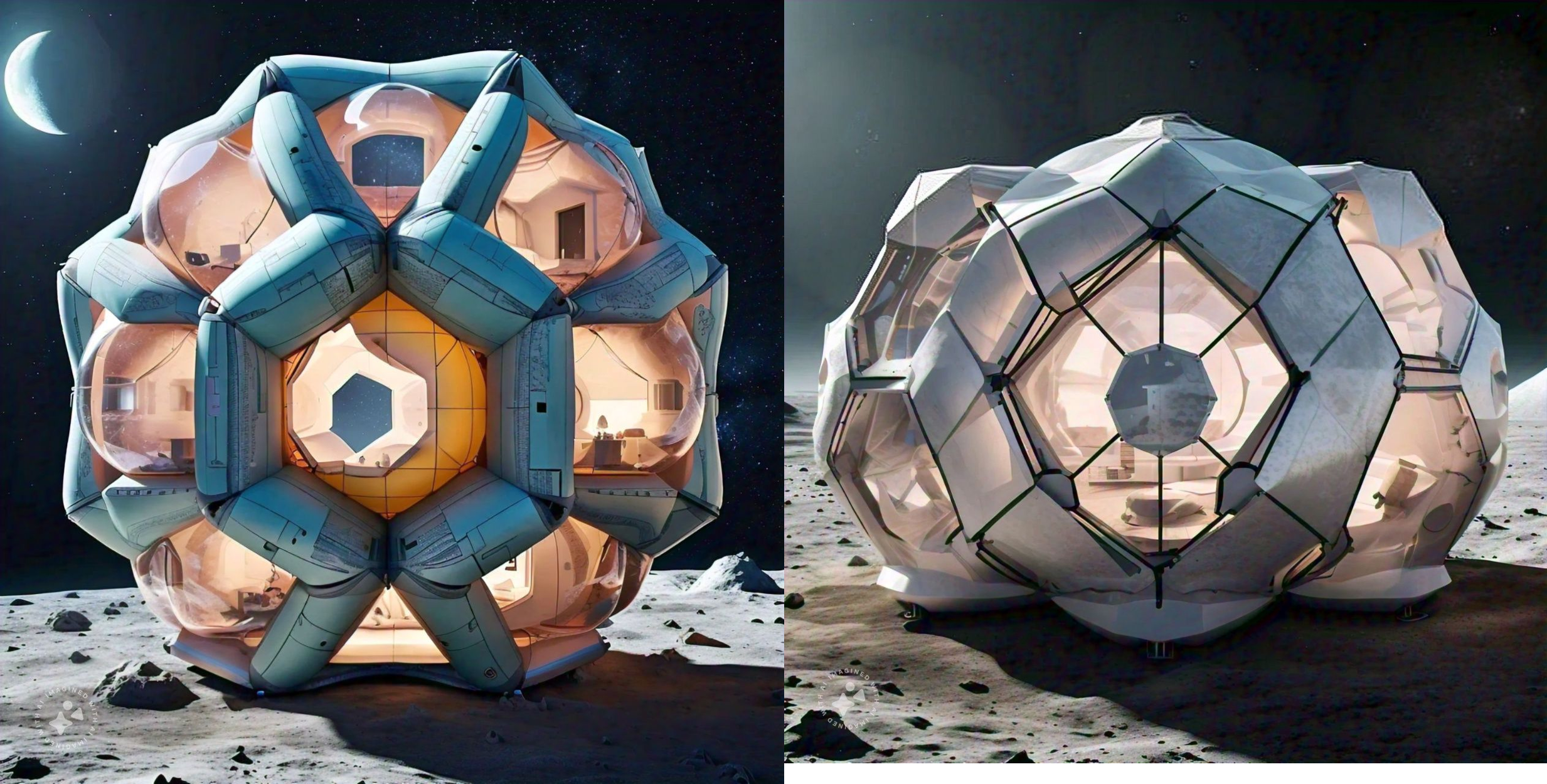Hybrid Habitat Module Design for a Lunar Base
A hybrid habitat module proposed for a lunar base made of a blend of inflatable and origami-inspired, hexagonal structural elements. This modular design ensures versatility, scalability, and adaptability to the challenging lunar environment. Designed for efficient use of materials, minimal energy consumption, and maximum durability, this habitat module addresses critical environmental stresses, structural demands, and human needs for a sustainable, comfortable off-Earth living space.
The module’s design addresses lunar environmental stresses through several layers of specialized protection. Given the moon’s exposure to high levels of solar and cosmic radiation, the exterior layer features a multi-functional shield with materials such as polyethylene composites or hydrogen-rich polymers to absorb and mitigate radiation exposure effectively. This layer also incorporates a debris-resistant outer membrane to protect against micrometeorites and lunar dust, which present ongoing hazards in the moon’s unshielded environment.
The hybrid structure includes a reinforcing framework composed of flexible, resilient alloys that resist UV radiation, low-gravity dust impacts, and thermal degradation. The modular and inflatable elements can be deployed with minimal risk of damage, even in extreme conditions, ensuring the longevity of the habitat.
Structural Responsiveness
The origami-inspired, hexagonal geometry of the habitat contributes to its overall resilience by distributing dynamic stresses evenly across its structure. The inflatable component adds flexibility, allowing the module to absorb dynamic lunar forces, including those that may arise from human movement, docking, or other activities. Additionally, the structure can withstand sudden changes in pressure, as the inflatable, layered walls can adapt to internal air pressure while maintaining their shape.
To address the lunar surface’s extreme thermal conditions, the module includes a combination of active and passive thermal management systems. A thermal insulating layer made of aerogel and other lightweight materials maintains internal temperature stability, while an embedded reflective surface layer reflects solar radiation. Moreover, strategically placed vents and advanced phase-change materials within the inflatable layers help regulate internal temperatures, ensuring a consistent environment for occupants.
Fabrication, Transportation, and Energy Considerations
Fabrication of the module components leverages additive manufacturing techniques for lightweight and adaptable construction. Components are produced using lunar resources where possible, such as regolith-based materials, to reduce dependency on Earth-supplied materials. Each module’s inflatable structure can be collapsed and compressed for efficient transportation, reducing payload costs. Once on the lunar surface, the habitat can be assembled and inflated quickly, minimizing human labor and energy expenditure.
The design includes an integrated solar energy system that powers the habitat and conserves resources. Solar panels are deployed on the module’s outer surface, capturing sunlight and converting it into energy to sustain life-support systems, environmental controls, and essential electronics. Energy-efficient LED lighting, water recycling systems, and air circulation components further enhance the module’s self-sufficiency and reduce overall power consumption.
Human Factors and Livability
Creating a comfortable and functional living environment is critical to the habitat’s long-term success. The hexagonal design provides ample interior space that can be customized for different functions. Each module includes windows with radiation-filtering glass to allow natural light, essential for occupants’ physical and psychological well-being. These windows also provide visual access to the lunar landscape, reducing the psychological effects of isolation and confinement.
The habitat is designed to support fundamental human needs, including designated spaces for food growth, sleep, and recreation. Hydroponic or aeroponic systems can be integrated into the module for efficient, low-maintenance food cultivation, which serves both as a nutritional source and a recreational activity. Separate sleeping quarters and recreation areas enhance privacy, relaxation, and mental health, contributing to a balanced lifestyle for astronauts.
Conclusion
In conclusion, the hybrid habitat module offers a practical, resilient solution for long-term lunar habitation. By addressing environmental and structural stresses, streamlining fabrication and transportation, and prioritizing human needs, this modular, inflatable, origami-inspired design represents a versatile and sustainable choice for future lunar explorers. The integration of radiation shielding, efficient energy use, and adaptive interior spaces creates a livable and robust environment that supports life on the moon, fostering both individual well-being and operational success

